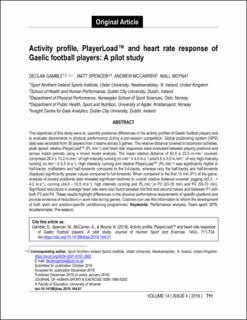| dc.contributor.author | Gamble, Declan | |
| dc.contributor.author | Spencer, Matthew | |
| dc.contributor.author | Mccarren, Andrew | |
| dc.contributor.author | Moyna, Niall | |
| dc.date.accessioned | 2020-05-11T11:57:33Z | |
| dc.date.available | 2020-05-11T11:57:33Z | |
| dc.date.created | 2020-01-28T14:18:50Z | |
| dc.date.issued | 2019 | |
| dc.identifier.citation | Journal of Human Sport and Exercise. 2019, 14(4), 711-724. | en_US |
| dc.identifier.issn | 1988-5202 | |
| dc.identifier.uri | https://hdl.handle.net/11250/2653903 | |
| dc.description | This work is licensed under a Attribution-NonCommercial-NoDerivatives 4.0 International (CC BY-NC-ND 4.0) - https://creativecommons.org/licenses/by-nc-nd/4.0/. | en_US |
| dc.description.abstract | The objectives of this study were to; quantify positional differences in the activity profiles of Gaelic football players and to evaluate decrements in physical performance during a pre-season competition. Global positioning system (GPS) data was recorded from 36 players from 3 teams across 5 games. The relative distance covered in locomotor activities, peak speed, relative PlayerLoad™ (PL.min-1 ) and heart rate responses were evaluated between playing positions and across match periods using a mixed model analysis. The mean relative distance of 92.4 ± 23.3 m.min-1 covered, comprised 28.4 ± 10.2 m.min-1 of high intensity running (m.min-1 ≥ 4.0 m.s-1 ) and 9.9 ± 3.9 m.min-1 of very high intensity running (m.min-1 ≥ 5.5 m.s-1 ). High intensity running and relative PlayerLoad™ (PL.min-1 ) was significantly higher in half-backs, midfielders and half-forwards compared to the full-backs, whereas only the half-backs and half-forwards displayed significantly greater values compared to full-forwards. When compared to the first 15 min (P1) of the game, analysis of pooled positional data revealed significant declines in; overall relative distance covered, jogging (≥2.0 - < 4.0 m.s-1 ), running (≥4.0 - <5.5 m.s-1 ), high intensity running and PL.min-1 ,in P2 (20-35 min) and P4 (55-70 min). Significant reductions in average heart rate were also found between the first and second halves and between P1 with both P3 and P4. These results highlight differences in the physical performance requirements of specific positions and provide evidence of reductions in work-rate during games. Coaches can use this information to inform the development of both team and position-specific conditioning programmes. | en_US |
| dc.language.iso | eng | en_US |
| dc.subject | performance analysis | en_US |
| dc.subject | team sport | en_US |
| dc.subject | GPS | en_US |
| dc.subject | accelerometer | en_US |
| dc.subject | pre-season | en_US |
| dc.title | Activity profile, PlayerLoad™ and heart rate response of Gaelic football players: A pilot study | en_US |
| dc.type | Peer reviewed | en_US |
| dc.type | Journal article | en_US |
| dc.description.version | publishedVersion | en_US |
| dc.rights.holder | © 2019 University of Alicante. | en_US |
| dc.source.pagenumber | 711-724 | en_US |
| dc.source.volume | 14 | en_US |
| dc.source.journal | Journal of Human Sport and Exercise | en_US |
| dc.source.issue | 4 | en_US |
| dc.identifier.doi | 10.14198/jhse.2019.144.01 | |
| dc.identifier.cristin | 1784270 | |
| dc.description.localcode | Seksjon for fysisk prestasjonsevne / Department of Physical Performance | en_US |
| cristin.ispublished | true | |
| cristin.fulltext | original | |
| cristin.qualitycode | 1 | |
